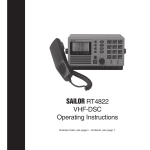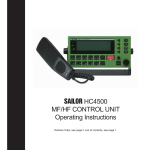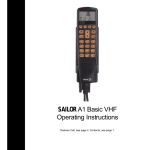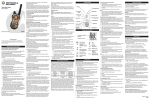Download SAILOR RT4822 VHF-DSC Operating Instructions
Transcript
SAILOR RT4822 VHF-DSC Operating Instructions Distress Calls, see page ii . Contents, see page 1. Acknowledgment DISTRESS Call Quick DISTRESS Call 1. If off or UNIT OFF: press ON/OFF. Distress acknowledgment received FROM: 002191000 VIEW Read call contents. 4. Press VIEW. 2. Open DISTRESS lid. 3. Press DISTRESS until RELEASE is displayed. This takes 5 seconds, during which the indicator lamps TX and ALARM will flash 5 - 4 - 3 - 2 - 1 - RELEASE Press the DISTRESS button for 5 seconds to transmit TYPE MSG. Pos Time : Distress : Undesignated : N:05°01E:009°54 : 18.12 UTC CANCEL Call contents first page Time: 18.22.06 19 Aug 97 TYPE : All station FROM: 002191000 CAT : Distress ACK : Call Call contents second page View next page. MORE CONNECT COMM: Distress ackn SHIP : 123456789 MSG. : Undesignated Pos : N:05°01E:009°54 AGAIN View call again. Mayday Procedure 5. Press “16”. 16 MEM VOL 25W INT SQ 2 13 06 6. Lift handset. Waiting for Distress Acknowledgment 16 Retransmit distress call every 4 minutes Wait for answer! CANCEL (The distress call is autorepeated every 3.5-4.5 minutes.) NB! ii DISTRESS is only to be used in case of an emergency! Press Press PTT and say: “MAYDAY” “This is” - the 9-digit identity and the call sign or other identification of the ship, - The ship’s position, - The nature of distress and assistance wanted, - any other information which might facilitate the rescue. “OVER.” Release PTT and listen for answer. Release 0144 What is What? 14 13 12 11 5 6 7 8 10 9 1 2 3 4 1. Display. 2. Indicator lamps. Condition when lit: Tx: Transmitting. 1W: 1 watt transmission mode. US: US channel system activated. (For information on the BI version, see page 11) CALL: DSC (see button 10) call for you received. ALARM: Alarm call received. 3. Loudspeaker. 4. Squelch control. Adjust to silent when no station is received. 5. ON/OFF push button. 6. Volume control. 7. Shift key. Press and hold for yellow functions. 8. DISTRESS button, protected by shield. To use, lift the shield and press for 3 seconds, guided by the text displayed. 9. Keyboard. 10. TEL/DSC function switch. In TEL mode radiotelephone parameters are shown and selected. In DSC mode DSC parameters are shown and selected. 11. Open the ADDR BOOK in DSC mode. 12. Tx CALL: Press to start creating a DSC call. 13. Open the Rx log of received calls in DSC mode. 14. Display keys. The function of each key is described in its respective line on the right side of the display. Abbreviations Used in this Manual ADDR ATIS BI DSC DUP DW GMDSS GPS LF MEM MMSI MSG PTT RX SQ STN TEL TX UTC Address Automatic Transmitter Identification System Channel mode used when sailing on European rivers (more details on p. 11) Digital Selective Calling Duplex Dual Watch Global Maritime Distress and Safety System Global Positioning System Low Frequency Memory Maritime Mobile Ship Identification Message Push-To-Talk Receive(r) Squelch Station Telephony Transmit(ter) Coordinated Universal Time iii Introduction S. P. Radio A/S For more than half a century S. P. Radio A/S has been the market leader within maritime radio communication. Sailor The communication products and systems of S. P. Radio are recognized under the brand name Sailor. The Sailor name has become a guarantee of reliable and technologically superior radio equipment, ranging from basic VHF units to satellite systems and complete compact GMDSS solutions. Products The SAILOR COMPACT 2000 GMDSS is based on the well proven range of Sailor products specifically developed to meet the GMDSS requirements and supported by a world-wide Certified GMDSS service concept, giving several hundred reasons for shipping companies to choose equipment manufactured by S. P. Radio A/S. Today S. P. Radio A/S is recognized as the world’s leading supplier of GMDSS solutions. The SAILOR COMPACT 2000 GMDSS has already been and still is constantly supplied to a large number of the world’s leading shipping companies and national naval fleets. It is a complete GMDSS solution which matches communication and safety needs exactly regardless of whether you operate with A1, A2, A3 or A4. The System 4000 GMDSS sets new standards. It is constructed on the basis of our comprehensive experience developing GMDSS equipment. It satisfies all the relevant requirements regarding safety and efficiency. The System 4000 presents a large number of attractive convenience and safety facilities, either as a complete solution or as a series of stand-alone products. Sailor has a long history as a satellite communications supplier offering a full programme of satellite systems which includes Mini M, SAT-C and a number of stationary satellite systems. Our SAT-B is a breakthrough in maritime aerial technology and reliability. The SAT-B is the best possible choice when high quality speech transmission, top level security and the capacity to deal with large volumes of telex, fax, data and high-speed data (HSD) transmissions are required. Training certification Training of deck officers to meet the requirements within the concept of GMDSS, as to operation of equipment and basic understanding of the systems, is an extremely important factor for the overall successful implementation of GMDSS. As a unique initiative for GMDSS solutions, we can supply a complete software training programme for on-board training, to be used as preparation in order to fulfil the GMDSS requirements for obtaining the General Operation Certificate. iv Service A world-wide Sailor GMDSS certified service concept has been established in order to provide the shipping industry with a highly professional and uniform level of service. The Sailor GMDSS Certified Service Centre concept, which is constantly monitored, ensures that replacement units and spare parts are available at all the Sailor Certified Service Centres around the world. Service centres which are in position along all the major shipping routes. Furthermore the Certified Service Centres ensure that technicians with an annually updated training are ready to provide service 24 hours a day, 365 days a year. Maintenance Because of the fact that GMDSS equipment has been installed on board ships in order to meet the SOLAS (Safety of Life At Sea) convention, manufacturers and suppliers of GMDSS equipment have a certain responsibility to secure reliable supplies of equipment and spares in the years to come. Therefore shipowners operating ships both locally and internationally should be fully aware of the importance of fitting GMDSS solutions which will be fully supported by the manufacturer. It is a firm policy of S. P. Radio A/S, as the world’s major manufacturer and supplier of GMDSS solutions, that for both the present GMDSS solutions and for future, alternative product solutions, all Sailor GMDSS systems will be entering the next century in fully parallel production. About this Manual This manual is for the daily user of the system. The manual includes two main sections, “basic” operation and “full” operation. The basic part offers a short easily-read description of the main functions; the full part offers elaborate descriptions of the functions of the product. Please note Any responsibility or liability for loss or damage in connection with the use of this product and the accompanying documentation is disclaimed. The information in this manual is furnished for informational use only, is subject to change without notice, may contain errors or inaccuracies, and represents no commitment whatsoever. This agreement is governed by the laws of Denmark. Doc. No.: B4822GB0 Issue: J/0547 Contents DISTRESS Call ..................................................................... ii Quick DISTRESS Call ....................................................... ii Acknowledgment ............................................................... ii Mayday Procedure ............................................................ ii What is What? ..................................................................... iii Abbreviations Used in this Manual .................................. iii Introduction ......................................................................... iv About this Manual .............................................................. iv VHF Fundamental Info ........................................................ 2 The VHF Channel System ............................................... 2 Verbal VHF Communication ............................................. 2 DSC Digital Communication ............................................ 2 Basic Operation ................................................................... 3 Switching ON/OFF ........................................................... 3 Basic Telephony Operation ................................................ 3 Listening for Telephony Calls ........................................... 3 Receiving a Telephony Call .............................................. 4 Making a Telephony Call .................................................. 4 Channel Control ............................................................... 5 Squelch Control ............................................................... 5 Setting the Volume Level ................................................. 6 Setting Transmitter Power Level ...................................... 6 Muting the Speaker .......................................................... 6 Dimmer Function .............................................................. 6 Basic DSC Operation .......................................................... 7 DSC Main Buttons ........................................................... 7 Position ............................................................................. 7 DSC Display Operation .................................................... 8 Calling a SHIP .................................................................. 8 Receiving an Individual Call ............................................ 9 Calling a SHORE Station ................................................. 9 Calling a PHONE NUMBER Directly ............................. 10 The ADDR BOOK ............................................................... 10 The Rx LOG ........................................................................ 11 Full Operation .................................................................... 12 Full VHF Telephony Operation .......................................... 12 Setting Channel Mode ................................................... 12 Setting International/US Channel Mode ........................ 12 Setting International/BI Channel Mode ......................... 12 25W Transmitter Power Level ........................................ 12 Setting Memory Scan Table ........................................... 13 Scanning of Channels .................................................... 13 Dual Watch ..................................................................... 15 Intercom ......................................................................... 16 Full DSC Operation ............................................................ Receiving DSC Calls ..................................................... TX CALL Menu ............................................................... Tone signalling when receiving DSC Calls ..................... Function Menu ................................................................... Changing a Function ...................................................... Functions Tree ................................................................ VHF System Description ................................................... International Channels ...................................................... US Channels ....................................................................... BI Channels ........................................................................ 18 18 19 21 22 22 23 24 25 26 27 1 VHF Fundamental Info Telephony display The VHF Channel System Normal display The VHF radio telephony system uses a limited number of frequencies called channels. The public system has 57 channels, numbered CH 1 to 28 and 60 to 88, each of which has a certain purpose: intership, ship-to-port, or ship-to shore (public). You can have private channels, too. In US waters, the channels are different. Therefore you need to set the system to “US” channels there. Other waters like the Rhine have their own different systems, too. Four channels have special purposes: 16: To be used for verbal distress calls and for calling “all stations” only. All large ships are obliged to monitor it constantly. Never to be used for chatting, etc.! 70: The DSC channel, see below. 75-76: Used as Guard Band for distress channel 16. DUP DW MEM 12 VOL 25W INT 1 10 03 Dimmer Scanning display DSC Digital Communication DSC is a digital data transfer system using VHF CH 70. The transmitter waits until the channel is free and then sends its data, either to a designated address, or to “all stations” for example for a DSC distress call. It is mainly used for getting in contact in order to establish verbal communication. 2 Pr MEM INT/US mode indication Speaker On/Off SQ Verbal VHF Communication All channels except channel 70 are used for verbal communication. There are two types of channels, simplex and duplex: - On a simplex channel, both parties transmit and receive on the same frequency. Therefore you cannot talk and listen at the same time. When you have finished talking, say “over”, and release the handset’s PTT key. - On a duplex channel, you talk and listen on two different frequencies. You can therefore speak and listen at the same time. To save power, release the handset’s PTT key except when talking. Note that everybody with a VHF receiver can listen to your conversation, but it is forbidden to use or pass on what is heard. TX Power indicator P-CH 7 ALL 16 25W INT Listening for Telephony Calls Basic Operation According to international rules, all ships shall monitor channel 16 constantly: Switching ON/OFF 1. Select channel 16 by pressing: 1. Press the ON/OFF button. 16 MEM VOL 16 25W INT MEM SQ INT SQ 1 10 03 1 10 03 In UNIT OFF mode, the VHF set is remote controlled. To activate the panel, press ON/OFF. VOL 25W 2. Set the squelch level by means of the button a. b. Step down squelch level until noise is heard on free channel. Then step up to the first level where just silent. (To listen for calls on other channels, select the channel number or use the scanning facility.) Basic Telephony Operation To activate the VHF functions if not active press the key TEL/DSC or the key “16”. or 3 Receiving a Telephony Call Making a Telephony Call When a call comes in and your call name is heard in the loudspeaker: In telephony mode: 1. Hook off the handset. 71 Press MEM 2. Press the PTT key on the handset. VOL 25W INT SQ 6 10 03 1. Select channel 16 or another channel specified or agreed upon: 3. To answer the call, say: “<The name of the calling station> This is <Your station name>“ 4. To suggest channel, say: “Channel” <suggested channel number>” 5. Say “over” and release the PTT key to let the caller accept the proposed channel number. 2. Hook off the handset. Release 6. Switch to the channel agreed upon (for example channel 71) and communicate: 71 MEM VOL 3. When speaking, press the handset PTT key. Press 25W INT SQ 6 10 03 Press the PTT key when talking only. If on a simplex channel, say “over” every time you have completed talking. Make the call: 1. <Called station name (3 times)> 2. “This is “ <Your station name (3 times)> 3. “Over” 4. Release the PTT key to listen. Release 5. When answered, agree upon a channel, switch to the channel (for example channel 6) and communicate. 6 MEM VOL 25W INT SQ 6 10 03 Press the PTT key when talking only. If on a simplex channel, say “over” every time you have completed talking. 4 Channel Control Setting the VHF channel can be done in two ways by means of the numeric input keys or by using the quick select key “16”: Numeric keys: Press the numeric input keys until the desired channel number is shown on the display: Quick select key: Press the key 16 MEM VOL 25W INT SQ 0 10 03 Squelch Control Set the squelch sensitivity of the receiver by the button 6 MEM VOL 25W INT SQ 1 08 02 The squelch setting is shown on the display below the “SQ” symbol. Ex: 71 MEM VOL 25W INT SQ 0 10 03 If private channels are available in your VHF system, a private channel number is selected by pushing the buttons: Ex: Private channel 23 P23 MEM VOL 25W INT SQ 0 09 01 5 Setting the Volume Level Muting the Speaker To change the volume setting use If the speaker is active, it is automatically muted when the PTT is pressed, and then reactivated when the PTT is released. 6 MEM VOL 25W The speaker icon on the display shows the speaker state. INT Speaker active: SQ 1 10 01 To mute or unmute the speaker, press the soft key 6 The volume setting is shown on the display below “VOL”. MEM VOL 25W INT SQ Speaker muted 1 00 04 Setting Transmitter Power Level Dimmer Function The VHF set can control the transmitter power level, which can be set to either 1W or 25W. The VHF set features display backlight, keyboard backlight and light in the indicator lamps (TX, 1W, US, CALL and ALARM). The light can be set in four steps 0-3. Low power 1W is indicated by the indicator lamp on the display. Some channels may be programmed to operate at 1W level only. To change the TX power level press the soft key. 6 MEM VOL SQ 1 08 04 1W indicator 6 1W To change the dimmer level press the soft key 6 25W INT INT LEVEL 2 When the key is being pressed the dimmer level will change every second. Position Basic DSC Operation The VHF 4000 system has a GPS interface for automatic position update. The actual known position and time for the last update is displayed in the DSC status display. If the position update from the GPS is missing or is invalid, a warning will be shown in the display and an alarm tone will sound. DSC Main Buttons To switch between the TEL and DSC screens, press TEL/DSC. CHANGE To manually update the position NO GPS update CANCEL 67 DSC status Channel: 70 POS: N:59°09 E:009°63 At UTC: 09.14 DSC status display or previously used DSC display MEM VOL To return to previous display 25W INT SQ 6 10 03 Telephony Display If the position is unknown or the known position has not been updated for more than 4 hours, an error-message “Position Error” is displayed and an alarm tone will sound. This is repeated every 10 minutes until the position is updated. In this situation, it is advisable to manually update the position by pressing CHANGE. CHANGE To manually update the position Position error The button opens the screen menu where all DSC calls are stored, for up to 48 hours. In this menu CALLS or ALARM CALLS can be read separately and sorted according to time of reception. The button opens the DSC transmitter menu. From here it is possible to make simple calls (SHORE, SHIP, ALL SHIP) and more complicated calls including special category and telecommands. (EXTENDED) The button opens the address book menu. An ADDR BOOK call is a complete DSC call incl. a name. It is possible to transmit, add or delete calls from here. The 0442 button switches between the TEL and the DSC screen. CANCEL To return to the previous display without changing position If the position information has not been updated for 23 1/2 hours, the position is considered unknown. When a GPS is not connected, the position can be entered manually through the menu Func DSC Position Change If the position is unknown, time/position will be shown as: Current GPS data UPDATE Time: 88:88:88 UTC NO GPS update S: 99°99’9999 W: 999°99’9999 CHANGE Time: 88:88:88 UTC S:99°99’9999 W:999°99’9999 Speed: 000.0 Knots Course: 000.0° CANCEL In the DSC status display and in outgoing DSC calls the position will be printed as unknown. 7 DSC Display Operation Calling a SHIP Featuring a self-explanatory menu-driven system, the display guides the user by textual instructions. Also, the function of each soft key placed to the right of the display is shown. Press TX CALL Opens the address book menu. Select type of call: SHORE SHIP To select a SHIP call. LAST CALL MORE Lower left corner of the display is the data area. Right side shows the function of the soft keys. Upper left corner of the display is used for textual instructions Use or keyboard to search in addr book Ms Magretha TO MSG : 219 219 219 : Working CH Select ADD to make a new call ACCEPT Key in the nine digit MMSI number of the wanted ship. To accept the data. ^ NAME v MORE To go to the next screen on the same subject. Key in the ship station MMSI number ADD AGAIN To accept the number. < DELETE CANCEL ACCEPT DIRECTORY One step back. To go to the first screen on the same subject. TYPE : Individual TO : 2190000016 CANCEL A submenu where a preprogrammed ship can be selected. A free international ship channel is suggested. Key in the working channel TYPE : Individual TO : 2190000016 AD : Working CH 08 Select send to transmit TYPE : Individual TO : 219000016 AD : Working CH 8 ACKN : Request ACCEPT To accept the channel. CANCEL SEND To transmit the call CANCEL You see the flashing messages “Call in progress” and “Waiting for acknowledgment” Wait for answer 8 0442 Receiving an Individual Call Calling a SHORE Station When switched on, your VHF set is constantly monitoring channel 70 for incoming DSC calls. Press TX CALL Lift the handset to connect to the caller. Lift HANDSET TO CONNECT Individual acknowledgment received FROM:219000016 or VIEW Call contents First page Time : 12:26:47 16 Sep 97 TYPE : Individual FROM : 219000016 CAT : Routine ACKN : Reply MORE Call contents Second page COMM: Simplex TEL2. : No info AD : Working CH 8 CONNECT INT To select a SHORE call. SHIP ALL STATIONS Press VIEW to read out the call. MORE Key in the nine digit MMSI number of the coast station. To view the second part of call. To change to telephony mode and set channel. Key in the coast station MMSI number ACCEPT To accept the number. < DIRECTORY TYPE : Individual TO : 002191000 CANCEL 25W 8 VOL SHORE CANCEL AGAIN MEM Select type of call: Key in the phone number ACCEPT A submenu where a preprogrammed coast station can be selected. To make an automatic phone station call. < SQ 2 13 07 TYPE : Phone call TO : Lyngby Radio 98180809 WITHOUT To delete the phone number. CANCEL Lift handset and start talking. Select send to transmit TYPE TO AD ACKN : : : : Individual Lyngby Radio No info Request SEND To transmit the call. CANCEL The messages “Call in progress” and “Waiting for acknowledgment” will flash. Wait for answer. 0442 9 Calling a PHONE NUMBER Directly Press TX CALL The ADDR BOOK Press ADDR BOOK to open the address book menu. Select type of call: SHORE To select a SHORE call. Use or keyboard to search in addr book SHIP ALL STATIONS Ms Magretha MORE TO : 219 219 219 MSG : Working CH 6 Key in the coast station MMSI number ACCEPT ACCEPT To accept the call, and go to the SEND menu. ^ NAME v MORE To go to the next page. To accept the number. < DIRECTORY TYPE : Individual TO : 002191000 CANCEL A submenu where a preprogrammed coast station can be selected. Select ADD to make a new call ADD To store a new call in address book register. DELETE To delete calls. CANCEL To return to telephony operation. AGAIN Key in the phone number. Key in the phone number ACCEPT To accept the number. < TYPE : Phone call TO : Lyngby Radio 98180809 Select send to transmit TYPE : Phone call TO : Lyngby Radio TEL : 98180809 ACKN : Request WITHOUT CANCEL ACCEPT To transmit the call. CANCEL The messages “Call in progress” and “Waiting for acknowledgment” will flash. Wait for answer. 10 0442 The Rx LOG Press RX LOG Select type of message to view CALLS ALARM CALLS To view ordinary calls. To view alarm calls. CANCEL ALARM CALLS buffer contains: Distress calls, distress acknowledgment, distress relay, and calls of category distress and urgency. CALLS buffer contains: All other types of calls Call contents first page TIME : 8:57:52 19 Aug 97 TYPE : Individual FROM : 219000330 CAT : Routine ACKN : Request ^ MSG v MORE Select CONNECT CONNECT to reply call COMM : Simplex CHANGE TEL2 : No info AD : Working CH 8 CANCEL AGAIN 0442 To scroll in the buffer. To go to the next screen. To reply to call and set channel. To change reply. To view first page again. 11 Full Operation Full VHF Telephony Operation Setting Channel Mode Some VHF radios offer a choice between two sets of channels, called channel modes. If your VHF features two modes, you can either switch between international/US channels, or between international/BI channels. International mode is used when sailing on any sea in the world, except in US waters. US mode is used when sailing in US waters. Setting International/BI Channel Mode If your VHF features the choice of international/BI mode, switching between those two sets of channels is done by pressing the soft key: 6 MEM VOL 25W INT SQ 1 08 01 BI mode is used when sailing on the rivers of Europe. Channel mode indication Setting International/US Channel Mode If your VHF features the choice of international/US mode, switching between those two sets of channels is done by pressing the soft key: 6 MEM VOL When BI mode is selected, the yellow BI indicator lamp is lit. Otherwise, the radio is in international mode. When BI mode is selected, ATIS is activated automatically. 25W INT SQ 1 08 01 25W Transmitter Power Level NB! For US channels 13 and 67. If the VHF is programmed with the set of US channels, some of those channels are specified to be used only with the limited transmitter power level of 1W. This means that the TX power level cannot be changed to 25W as described. Channel mode indication When US mode is selected, the yellow US indicator lamp is lit. Otherwise, the radio is in international mode. However, it is still possible to set the TX power level to 25W by using: 13 MEM VOL 25W INT SQ 1 08 01 When the key has been pushed for 1 second the TX power level will change if allowed. 12 0442 Setting Memory Scan Table Scanning of Channels The VHF 4000 system has eight independent sets of memory tables to save channels for making scanning sessions. Each memory table may contain all channels available in the system. To distinguish between the tables, each table has a number (0-7) and to each number can be attached a name of maximum seven characters. To attach a name to a scan table, enter the function menu. To start scanning: The scan table number selected is shown in the left corner of the display. 6 MEM VOL 25W INT 7 09 01 Pre-programmed memory tables for scanning of channels: Table 6: Channels for intership communication. Table 7: All channels in system. SEL 25W INT MEM 7 ALL The VHF set display shows the message “SEL”ect and the MEM symbol. The lower part of the display shows the scan table’s number and name. 6 2. Press The VHF display now shows the new scan table number 0. 0442 INT PCH 7 ALL 16 The lower part of the display shows from left to right: scan table number, scan table name and priority channel of scan table. NO 25W INT To stop scanning: Scanning in progress can be terminated in the following ways: 1. Press The system resumes normal VHF operation on the channel selected before the scanning session was initiated. Setting the selected scan table: To set the selected scan table to be number 0: MEM MEM MEM EMPTY It is recommended not to alter the pre-programmed channels in scanning tables 6 and 7. These scanning tables are used to search for channels for intership DSC communication, and altering the channels may exclude you from performing intership communication on certain channels. 1. Press Press If scan table contains no channels, no scanning will be started, and the display will show the following message: SQ 25W Pr - VOL SQ 0 09 01 2. Press The system resumes normal VHF operation on quick select channel 16. 3. Hook off the handset. The system resumes normal VHF operation on the channel selected before the scanning session was initiated. 4. Push the PTT 25W INT If no signal has been detected on any channel, the system resumes normal VHF operation on the channel selected before the scanning session was initiated. If a signal has been detected on a channel, the system resumes normal VHF on the last channel where signal was detected. 13 If scanning is in progress and a signal is detected on eg. channel 6, the display changes to show the selected channel number and volume level. When a priority scanning is in progress, channel 16 is scanned once for every channel scanned in the scan table. Channel 16 cannot be deleted or excluded while a scanning is in progress. 25W 6 MEM VOL To delete a channel from a scan table: Select channel number (shown on the display), and then press Ex: To delete channel 6 from scan table number 1: INT P-CH 6 1. Press 7 09 16 Channel 6 is selected. To add a channel to a scan table: Select channel number (shown on the display), and then press MEM VOL 2. Press Channel 6 is selected. MEM VOL SQ 6 The message “delete channel” is shown for one second. 6 INT 1 08 04 Ex: To add channel 6 to scan table number 1: 1. Press 25W 25W INT 25W DELETE CH INT SQ 1 08 04 Then the display will show the next channel in the scan table. 7 MEM 2. Press The message “stores channel” is shown for two seconds. 6 STORES CH VOL 25W INT SQ 1 09 01 25W INT If there are no more channels in the scan table and deletion is attempted, the display will show the message “mem empty”. NO 25W INT MEM EMPTY 14 0442 To view contents of channels in a scan table: Viewing which channels a specific scan table contains, can be done in two ways: While key is being pressed down, the VHF display will step through the channels of the scan table selected. Dual Watch 1. Press Then press , the latter for 1 second. The VHF set may perform a dual watch of channels, a priority channel and the selected channel being monitored simultaneously. To start a dual watch of channel 6 and priority channel 16: Select channel 6. OR 2. Press , the latter for 1 second. 12 MEM When a dual watch is in progress, “DW” appears on the display and the priority channel is shown in the lower right corner of the display. 6 DW MEM VOL 25W INT P-CH 1 08 16 25W INT To stop a dual watch: When a dual watch is in progress it can be terminated in three ways. 0 CONTENT 1. Press 6 MEM VOL 25W INT SQ 1 08 04 2. Push PTT The system resumes VHF on the selected channel 6 and starts transmitting. 16 3. Push MEM VOL 25W INT SQ 1 08 04 The system resumes VHF on the quick select channel (normally 16). 0442 15 Intercom If your VHF system has more than one control unit, it is possible to carry out an intercom between two control units. When the intercom feature is used the VHF will perform as follows: Initiating an intercom from the VHF set to another control unit: To call another control unit: 1. Press IC SELECT NO This display indicates that the unit expects an input of the location number to be called. 2. Press a numeric key to choose location to be called Ex: 3. If location 2 is NOT available, the display shows and no dialling is carried out. If location 2 is available the display shows and a ringing tone is heard in the speaker/earpiece. 16 IC2 NOT AVAIL IC2 CALLING 0442 This indicates that a dial-up is in progress to the control unit with location number 2. The lower part of the display now toggles the message CALLING and the NAME of the called control unit. During the dialling time of 30 seconds it is possible to hook off the handset and speak into the microphone. As LF is activated in the called control unit during dialling, the receiver of the call can hear you in the speaker without hooking off. This makes it possible to use the VHF system as a sort of paging system. 4. If the intercom attempt is answered: When the receiver of the call hooks off his handset, the intercom is established. IC2 “NAME” If the intercom attempt is not answered within 30 seconds, the unit automatically hangs up and reenters normal VHF operation. During intercom the unit is able to: 1. Adjust volume level 2. Mute/unmute speaker 16 MEM VOL 3. Adjust squelch level 4. Adjust dimmer level SQ 1 10 03 Receiving an intercom attempt from another control unit: When an intercom is attempted from another control unit, the following will happen (the caller has location number 3). 1. Receiving an intercom Terminating an intercom session: The intercom connection can be terminated by either of the control units. To end an intercom: 1. Place handset on hook. The VHF set resumes in VHF mode. IC3 The display toggles CALLING and the NAME of the caller. A ringing tone is heard in the speaker. CALLING 2. Key The VHF set resumes in VHF mode. 2. To answer the intercom, hook off handset. 3. Key The VHF set resumes in VHF mode selecting channel 16. The intercom connection is now established; to communicate, simply press PTT and speak into the microphone. 0442 17 Full DSC Operation Furthermore the unit does as follows: 1. If on hook: Receiving DSC Calls A. If VHF mode active: When a DSC call is received, the user will be advised by the unit. This is done in different ways, depending on the type of DSC call and the unit operation mode: Lift HANDSET TO CONNECT Individual call received Sound, CALL indicator lamp or CALL and ALARM indicator lamps. FROM:”MMSI NO” VIEW The unit automatically changes to DSC mode. B. If DSC mode or function menu active, the unit continues the function in progress. Select type of call: SHORE SHIP LAST CALL MORE 2. If hooked off: A. If VHF mode active: The unit continues in VHF mode, for your VHF control. Press to view the limited call contents as in 1 A. B. If DSC mode or function menu active: The unit continues the function in progress. In all cases, to view all DSC call contents: and view all call contents by Press entering the RX LOG menu. 18 0442 TX CALL Menu An extended DSC call makes it possible for you to control the call completely within international rules, including the possibility of sending data or fax from optional equipment connected to your VHF set. Select type of call: To start an extended call, select EXTENDED as the “Type of call” in the TX menu below, and then continue in the extended calls menu on next page. All ships safefy call. DISTRESS To complete distress call. EXTENDED Extended calls. MORE Select type of extended call Press TX CALL ALL SHIPS INDIVIDUAL GROUP G.AREA TYPE: Select type of call: SHORE Select type of extended call SHIP LAST CALL MORE To go to the second page in EXTENDED menu. ALL SHIPS DISTRESS RELAY To return to last call. MORE CANCEL TYPE: AGAIN TX CALL menu. Enter correct data instead of examples: Type of call Address Options SHORE Shore: 001234567 No info: Call shore station Shore -->Phone: or from 98765432: Call Phone No. ADDR.BOOK SHIP 123456789 (none) LAST CALL Repeat the last call made. ALL SHIPS All ships (none) DISTRESS COLLISION SINKING PIRACY UNDESIGNATED GROUNDING MAN OVER BOARD ABANDONING SHIP FLOODING FIRE LISTING (CAPSIZING) DISABLED AND ADRIFT EXTENDED (See next page) VTS CALL (Reserved for future use) 0442 Other data transmitted Routine - Simplex Routine - Simplex - <Phone number> Add. MSG. No info No info Ackn. Yes Yes Routine - Simplex - No Info Working ch xx Yes Safety - Simplex - No Info Working ch xx No Position UTC time for position No ... to be entered manually if not obtained from e.g. a GPS. 19 EXTENDED TX call started from “EXTENDED” in the table on the previous page. Enter correct data instead of examples: Type of call Address INDIVIDUAL Phone 001234567 Shore: 001234567 Ship: 123456789 GROUP 012345678 G.AREA N:57° d02° W:009° d03° The data in the example gives the area: N:57..55° W:9..6° Options Phone number Category Routine Telecom 1 Simplex SIMPLEX POLLING POSITION NO INFO FAX ARQ DATA ROUTINE URGENCY DISTRESS SAFETY BUSINESS Unable to comply ALL SHIPS DISTRESS RELAY Type of Address address ALL SHIPS All ships INDIVIDUAL 001234567 DISTRESS Simplex URGENCY No info SAFETY FAX ARQ DATA Ship in Distressed Distress distress ship's MMSI UNKNOWN KNOWN 123456789 Telecom 2 No info No info MEDICAL NEUTRAL No info No info V.21 V.22 V.22 bis V.23 V.26 bis V.26 ter V.27 ter V.32 No reason Congestion Busy Queue Station barred No operator Temporarily engaged Equipment disabled Bad channel Bad mode No info Add. MSG. Ackn. No info Yes Yes/No No info Position Working ch xx Working ch xx No No As for DATA above As for Position DISTRESS in table Tx Call menu MMSI address rule: Shore station numbers start with 00, group numbers start with 0, ship numbers start with a digit 1-9. 20 0442 Tone signalling when receiving DSC Calls 30 sec. Restarts after 30 sec. TONE SIGNAL DISTRESS CALL DISTRESS & URGENCY 1 sec. 7 sec. VHF CONNECT 3 sec. ALL SHIP SAFETY CALLS OTHER DSC CALLS 35294 The tone signalling sequence is repeated every 30 seconds or until the DSC call is either read or answered. When handset is hooked off, there is a short tone every 30 seconds until call is read. Please note that if the radio receive a distress call when the speaker volume is less than 10, the volume will be 10 until you change it back again. 0442 21 Function Menu Changing a Function There are a large number of function settings available, selectable from a functions tree, see next page. This chapter only deals with the principles of how to use the functions tree. Example used: Changing the display contrast. Press SHIFT and FUNC to enter function menu. Select function or group of settings USER To select the USER function. TELEPHONY DSC MORE Select type of general user functions DISPLAY To open display settings. SOUND VERSION MORE Select type of display settings CONTRAST To open contrast menu. BACKLIGHT MODE AGAIN Use to change value ACCEPT ^ Contrast : 4 v CANCEL 22 ACCEPT stores the selected value in memory. ^ To change contrast value v To change contrast value (up = darker) (down = lighter) CANCEL leaves this menu and reloads the old contrast value. 0442 Functions Tree Menu Submenu Level 1 Submenu Level 2 Parameters USER DISPLAY CONTRAST 0 to 7. High contrast = 7. BACKLIGHT Settings for each of the "Level 0..3" backlight levels on the TEL display. Display: Backlight (0..7, no light = 0) Keyboard: Backlight. ON/OFF. SOUND MODE Dimmer mode: To minimum / To centre, To maximum. EARPIECE EARPIECE level : 0 to 15. ALARM Loudspeaker ALARM level: 0 to 15. SPEAKER Selects if the loudspeaker is to be active with handset OFF. VERSION Software version. Your apparatus' serial number. PRINT SETUP Printer: ON/OFF / Codes. Paper width: 80 or 24 char. LANGUAGE The languages selectable TELEPHONY CHANNELS Only active if allowed. Read out VHF channel information SCANNER DSC Selects the language of the display texts. Setup/edit name of scan tables ATIS Your station's ATIS number MMSI Your station's MMSI number. POSITION * TIME Automatic if connected to a GPS or equiv., otherwise enter here. CHANGE Automatic if connected to a GPS or equiv., otherwise set here. Local time zone: -12 to + 12 (-12 to +12). Displays Time hh mm ss: (0-23:59:59h). time and date Date: dd-mm-yy. TEST DSC TEST CALLS AUTO ACKN Auto acknowledgment on request: ON/OFF. With position data: ON/OFF. DIRECTORY ADD Adds new entry in the DIRECTORY register. DELETE Deletes an entry. VIEW Key in "9876" *) Note: 0442 UNIT Views the contents of the DIRECTORY. LOCATION 1 to 7 unique number of control unit. NAME Unit name, e.g. "BRIDGE". SPEAKER Must be set to 1. Not to be changed for future use. If time of position is different from current time: 1. Select 'Time' and key in the time of position. 2. Select 'Position' and key in the position. 23 VHF System Description To the VHF system can be connected up to 7 control units. Each control unit has a unique location (1-7). If a control unit wants to control the transceiver, it has to be master of the system. The following describes the display read-outs shown in connection with different system priorities of the control units: The control unit assigned location number 1 has the highest priority in the VHF system and is able to become master of the system at any time needed. When more control units are connected to the VHF system, the main control unit has to be assigned location number 1. When a control unit is master of the system, the other control units, if in VHF mode, show the following display to indicate that the transceiver is in use by another control unit: oCC 1 BRIDGE The control unit location name The control unit location number When the system is free: If a control unit is in VHF mode, it shows the VHF display. 6 MEM VOL 25W INT SQ If the other control units are in DSC mode or the function menu is active, the display will show the menu item as usual. Select type of call: SHORE SHIP 1 08 02 LAST CALL MORE If a control unit in DSC mode or the function menu is active, the display shows the menu item. Select type of call: SHORE SHIP LAST CALL MORE Getting the MASTER priority in the system: To operate the transmitter, the control unit has to be master of the system. To become master of the system, simply hook off the handset. When the control unit becomes master of the system, the display will not change. If the control unit does not become master of the system and it is operated in VHF mode, the display will show the message: oCC 1 BRIDGE If the system is occupied by another control unit, hang up and wait for the system to become free. 24 0442 International Channels Channels 1 2 3 4 5 6 7 8 9 10 11 12 13 14 15 16 17 18 19 20 21 22 23 24 25 26 27 28 TX MHz 156,050 156,100 156,150 156,200 156,250 156,300 156,350 156,400 156,450 156,500 156,550 156,600 156,650 156,700 156,750 156,800 156,850 156,900 156,950 157,000 157,050 157,100 157,150 157,200 157,250 157,300 157,350 157,400 RX SIMPLEX MHz Intership Port 160,650 160,700 160,750 160,800 160,850 156,300 160,950 156,400 156,450 156,500 156,550 156,600 156,650 156,700 156,750 156,800 Distress and calling 156,850 161,500 161,550 161,600 161,650 161,700 161,750 161,800 161,850 161,900 161,950 162,000 DUPLEX Port Public Channels 60 61 62 63 64 65 66 67 68 69 70 71 72 73 74 75 76 77 78 79 80 81 82 83 84 85 86 87 88 TX MHz 156,025 156,075 156,125 156,175 156,225 156,275 156,325 156,375 156,425 156,475 156,525 156,575 156,625 156,675 156,725 156,775 156,825 156,875 156,925 156,975 157,025 157,075 157,125 157,175 157,225 157,275 157,325 157,375 157,425 RX SIMPLEX MHz Intership Port 160,625 160,675 160,725 160,775 160,825 160,875 160,925 156,375 156,425 156,475 156,525 DSC DSC 156,575 156,625 156,675 156,725 156,775 L) 156,825 L) 156,875 161,525 161,575 161,625 161,675 161,725 161,775 161,825 161,875 161,925 157,375 *) 157,425 *) DUPLEX Port Public Notes: L) *) NB! 0442 1 W TX power. Due to the introduction of the channels AIS1 at 161.975 MHz and AIS2 at 162.025 MHz for Automatic Identification System, channels 87 and 88 became simplex channels as of 1 January 1999. The RX and TX frequencies can be read out on the control unit handset by pressing (for more than one second) and holding the CH key. At a front-operated VHF radio, the RX and TX frequencies can be displayed on a menu. 25 US Channels Channels 1 2 3 4 5 6 7 8 9 10 11 12 13 14 15 16 17 18 19 20 21 22 23 24 25 26 27 28 TX RX SIMPLEX MHz MHz 156,050 156,050 DUPLEX B) 156,150 156,150 !) B) 156,250 156,300 156,350 156,400 156,450 156,500 156,550 156,600 156,650 156,700 156,800 156,850 156,900 156,950 157,000 157,050 157,100 157,150 157,200 157,250 157,300 157,350 157,400 156,250 156,300 156,350 156,400 156,450 156,500 156,550 156,600 156,650 L) 156,700 156,750 RX) 156,800 Distress and calling 156,850 156,900 156,950 157,000 157,050 !) 157,100 157,150 !) 161,800 161,850 161,900 161,950 162,000 Channels 60 61 62 63 64 65 66 67 68 69 70 71 72 73 74 75 76 77 78 79 80 81 82 83 84 85 86 87 88 TX MHz RX MHz SIMPLEX 156,075 156,075 DUPLEX Channels WX B) P1 P2 P3 P4 P5 P6 P7 P8 P9 P10 WX1 WX2 WX3 WX4 WX5 WX6 WX7 WX8 WX9 WX10 !) B) 156,175 156,225 156,275 156,325 156,375 156,425 156,475 156,525 156,575 156,625 156,675 156,725 156,175 156,225 156,275 156,325 156,375 156,425 156,475 156,525 156,575 156,625 156,675 156,725 !) L) RX MHz 162,550 162,400 162,475 162,425 162,450 162,500 162,525 161,650 161,775 163,275 DSC B) B) 156,875 156,925 156,975 157,025 157,075 157,125 157,175 157,225 157,275 157,325 157,375 157,425 156,875 156,925 156,975 157,025 157,075 157,125 157,175 161,825 161,875 161,925 157,375 157,425 L) !) !) !) Notes: L) B) !) RX) NB! 26 1W TX power. By pressing the 25W button in the US hook, the transmitter will transmit 25W on channels 13 and 67, which are normally limited to 1W transmission. Channels 2, 4, 60, 62, 75 and 76 cannot be selected in US mode. Channels 3, 21, 23, 61, 64, 81, 82 and 83 may be legally used in certain instances, but they are not for use by the general public in US waters. Only RX. Transmitter is blocked. The RX and TX frequencies can be read out on the control unit handset by pressing (for more than one second) and holding the CH key. At a front-operated VHF radio, the RX and TX frequencies can be displayed on a menu. 0547 BI Channels Channels 1 2 3 4 5 6 7 8 9 10 11 12 13 14 15 16 17 18 19 20 21 22 23 24 25 26 27 28 TX MHz 156,050 156,100 156,150 156,200 156,250 156,300 156,350 156,400 156,450 156,500 156,550 156,600 156,650 156,700 156,750 156,800 156,850 156,900 156,950 157,000 157,050 157,100 157,150 157,200 157,250 157,300 157,350 157,400 RX SIMPLEX MHz Intership Port 160,650 160,700 160,750 160,800 160,850 156,300 L) 160,950 156,400 L) 156,450 156,500 L) L) 156,550 L) 156,600 L) 156,650 L) L) 156,700 L) 156,750 L) L) 156,800 Distress and calling 156,850 L) L) 161,500 161,550 161,600 161,650 161,700 161,750 161,800 161,850 161,900 161,950 162,000 DUPLEX Port Public Channels 60 61 62 63 64 65 66 67 68 69 70 71 72 73 74 75 76 77 78 79 80 81 82 83 84 85 86 87 88 TX MHz 156,025 156,075 156,125 156,175 156,225 156,275 156,325 156,375 156,425 156,475 156,525 156,575 156,625 156,675 156,725 156,775 156,825 156,875 156,925 156,975 157,025 157,075 157,125 157,175 157,225 157,275 157,325 157,375 157,425 RX SIMPLEX MHz Intership Port 160,625 160,675 160,725 160,775 160,825 160,875 160,925 156,375 156,425 156,475 156,525 DSC DSC 156,575 L) 156,625 L) 156,675 156,725 L) 156,775 B) 156,825 B) 156,875 L) 161,525 161,575 161,625 161,675 161,725 161,775 161,825 161,875 161,925 157,375 *) 157,425 *) DUPLEX Port Public Notes: B) L) *) NB! 0442 Channels 75 and 76 cannot be selected in BI mode. 1W TX power on channels 6, 8, 10, 11, 12, 13, 14 ,15, 17, 71, 72, 74, and 77. Due to the introduction of the channels AIS1 at 161.975 Mhz and AIS2 at 162.025 MHz for Automatic Identification System, channels 87 and 88 became simplex channels as of 1 January 1999. - The ATIS function is enabled on all channels. - The RX and TX frequencies can be read out on the control unit handset pressing (for more than one second) and holding the CH key. At a front-operated VHF radio, the RX and TX frequencies can be displayed on a menu. 27















































